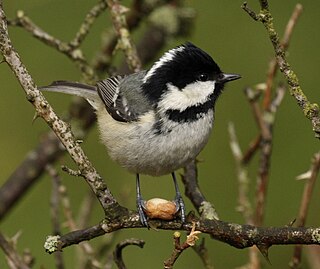
The coal tit, is a small passerine bird in the tit family, Paridae. It is a widespread and common resident breeder in forests throughout the temperate to subtropical Palearctic, including North Africa. The black-crested tit is now usually included in this species.

The great tit is a small passerine bird in the tit family Paridae. It is a widespread and common species throughout Europe, the Middle East, Central Asia and east across the Palearctic to the Amur River, south to parts of North Africa where it is generally resident in any sort of woodland; most great tits do not migrate except in extremely harsh winters. Until 2005 this species was lumped with numerous other subspecies. DNA studies have shown these other subspecies to be distinct from the great tit and these have now been separated as two distinct species, the cinereous tit of southern Asia, and the Japanese tit of East Asia. The great tit remains the most widespread species in the genus Parus.
The Serravallian is, in the geologic timescale, an age or a stage in the middle Miocene Epoch/Series, which spans the time between 13.82 Ma and 11.63 Ma. The Serravallian follows the Langhian and is followed by the Tortonian.

The Cyrillaceae are a small family of flowering plants in the order Ericales, native to warm temperate to tropical regions of the Americas. The family comprises two genera, Cliftonia and Cyrilla, each containing a single species, Cliftonia monophylla and Cyrilla racemiflora. However, additional species of Cyrilla are now often recognized and the genus is in need of taxonomic revision.

Parus is a genus of Old World birds in the tit family. It was formerly a large genus containing most of the 50 odd species in the family Paridae. The genus was split into several resurrected genera following the publication of a detailed molecular phylogenetic analysis in 2013. The genus name, Parus, is the Latin word for "tit".
Praepusa is an extinct genus of earless seals from Neogene marine deposits in Europe. Five species, P. boeska,P. magyaricus, P. pannonica, P. tarchankutica and P. vindoboensis, are known.
Carduelis parvulus is an extinct species of Carduelis that inhabited Hungary during the Neogene period.
Saxicola baranensis is an extinct species of Saxicola that inhabited Hungary during the Neogene period.
Calandrella gali is an extinct species of Calandrella that inhabited Hungary during the Neogene period.
Melanocorypha minor is an extinct species of Melanocorypha that inhabited Hungary during the Neogene period.
Luscinia pliocaenica is an extinct species of Luscinia that inhabited Hungary during the Neogene period.
Lullula minuscula is an extinct species of Lullula that inhabited Hungary during the Neogene period.
Lullula minor is an extinct species of Lullula that inhabited Hungary during the Neogene period.
Lullula parva is an extinct species of Lullula that inhabited Hungary during the Neogene period.
Riparia minor is an extinct species of Riparia that inhabited Hungary during the Neogene period.
Parus robustus is an extinct species of Parus that inhabited Hungary during the Neogene period.
Parus medius is an extinct species of Parus that inhabited Hungary during the Neogene period.
Phylloscopus pliocaenicus is an extinct species of Phylloscopus that inhabited Hungary during the Neogene period.
Emberiza pannonica is an extinct species of Emberiza that inhabited Hungary during the Neogene period.
Delichon pusillus is an extinct species of Delichon that inhabited Hungary during the Neogene period.



